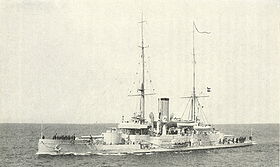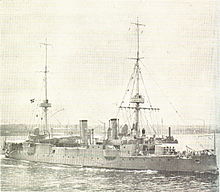Olfert Fischer (ship)
|
|
|
|---|---|
 The Olfert Fischer 1913 |
|
| Overview | |
| Type | Coastal armored ship |
| Shipyard | |
| Keel laying | 20th October 1900 |
| Launch | May 9, 1903 |
| Namesake | the Admiral Olfert Fischer |
| Commissioning | May 31, 1905 |
| Whereabouts | Sold for demolition in 1937 |
| Technical specifications | |
| displacement |
3,650 t |
| length |
86.5 m over everything |
| width |
15.4 m |
| Draft |
5.0 m |
| crew |
254 men |
| drive |
6 Thornycroft boilers , |
| speed |
15.8 kn |
| Range |
2500 nm at 9 kn |
| Armament |
2 × 24 cm L / 43 Bofors cannons |
| Fuel supply |
... tons of coal |
| Armored deck |
64 to 190 mm |
|
Armament 1905–1910 |
|
| 1910 |
2 additional 57 mm guns |
| 1916 |
6 × 75 mm and 2 × 57 mm guns, revolver cannons removed |
The Danish coastal armored ship Olfert Fischer , commissioned in 1905, was the second of three ships in the Herluf Trolle class with two 24 cm individual towers. She retired from service in the Danish fleet in 1936. The ship was named after Vice Admiral Olfert Fischer (1747-1829), the Danish commander in the 1801 naval battle of Copenhagen .
Building history
The Olfert Fischer was the first sister ship of the Herluf Trolle and had some improvements over the type ship. The armor was strengthened by using hardened Krupp steel, the most modern armor steel at the time. The belt armor of the Olfert Fischer now also extended over the entire length of the hull. The 24 cm Canet cannons of the Herluf Trolle were replaced on the Olfert Fischer by slightly longer 24 cm L / 43 cannons from the Swedish company Bofors , which had a range of 13,700 m compared to the 11,500 m of the Canet model whose rate of fire was 1.8 rounds per minute (versus 1.3). The use of slightly more modern 15 cm cannons from the same manufacturer brought only minor improvements with a range of 10,400 m and a rate of fire of 7 rounds per minute.
Since the previous fleet flagship Helgoland was due to be scrapped, the new coastal armored ship received additional admiral rooms in order to serve as the flagship of the Danish fleet in the future.
Mission history
The Olfert Fischer was born on May 31, 1905 for the first time into service and took over as early as 15 June, a special task as she considered the flagship of the Danish flotilla with the small protected cruiser Gejser the royal yacht Dannebrog with Prince Carl and his wife Maud of Oslo brought . The prince had been elected king of Norway , which had just become independent .
From 1906 to 1912 Olfert Fischer regularly took part in squadron exercises. From May 12 to 17, 1912, she escorted the Dannebrog with the coffin of the Danish King Friedrich VIII, who died in Hamburg , from Travemünde to Copenhagen. In the winter of 1912/1913 she was again part of the winter squadron.
On August 2, 1914, the neutrality watch of the Danish navy began for the Olfert Fischer in the First World War , which ended for them on November 27, 1918. During this time, the three ships of the Herluf Trolle class changed their duties several times between the 1st Squadron on the Öresund , the 2nd Squadron on the Great Belt and the role of fleet flagship.
In 1920, the ship initially went to North Schleswig to take action against marauding Russian prisoners of war, and then transported Danish troops to the local voting districts. The Olfert Fischer was part of the training squadron in autumn. In 1921, together with Peder Skram , she carried out tests with HM-1 seaplanes (machines of the Hansa-Brandenburg W.29 type built under license). In 1922 she was more of a stationary training ship , in 1923 she also made a few short trips. In 1924 it was also activated without making any trips.
In 1926 she made a few voyages in Danish waters and was the flagship of the training squadron in autumn. In 1928 she made a few trips as an artillery training ship on her own before joining the maneuver squadron in the fall. In 1930 the ship was assigned to the reserve and then again in 1933 to become an artillery training ship, to carry out some independent trips in this function and then to take part in the fleet maneuvers for the last time in autumn.
From October 5 to 17, 1936, the partially dismantled ship served as a target ship for the army and navy air forces. The experiments took place in the fax box . The results were disappointing because of the low hit rate. The ship was subsequently canceled in Denmark.
The Danish coastal armored ships
| Surname | Launch | displacement | speed | Main armament |
|---|---|---|---|---|
| Tordenskjold | September 30, 1880 | 2,534 t | 13.3 kn | 1 × 35.5 cm L / 25 |
| Iver Hvitfeldt | April 14, 1886 | 3,478 t | 15.1 kn | 2 × 26 cm L / 35 |
| Skjold | May 8, 1896 | 2,195 t | 13.4 kn | 1 × 24 cm L / 40 |
| Herluf trolls | September 2, 1899 | 3,505 t | 15.6 kn | 2 × 24 cm L / 40 |
| Olfert Fischer | May 9, 1903 | 3,650 t | 15.8 kn | 2 × 24 cm L / 43 |
| Peder Skram | May 2, 1908 | 3,735 t | 16.0 kn | 2 × 24 cm L / 43 |
Renewed use of the name Olfert Fischer
From 1981 to 2009 the Danish Navy had the Corvette Olfert Fischer of 1320 t in service. Her sister ships were called Niels Juel and Peter Tordenskjold .
literature
- R. Steen Steensen: Vore panserskibe. Marinehistorisk Selskab, 1968


